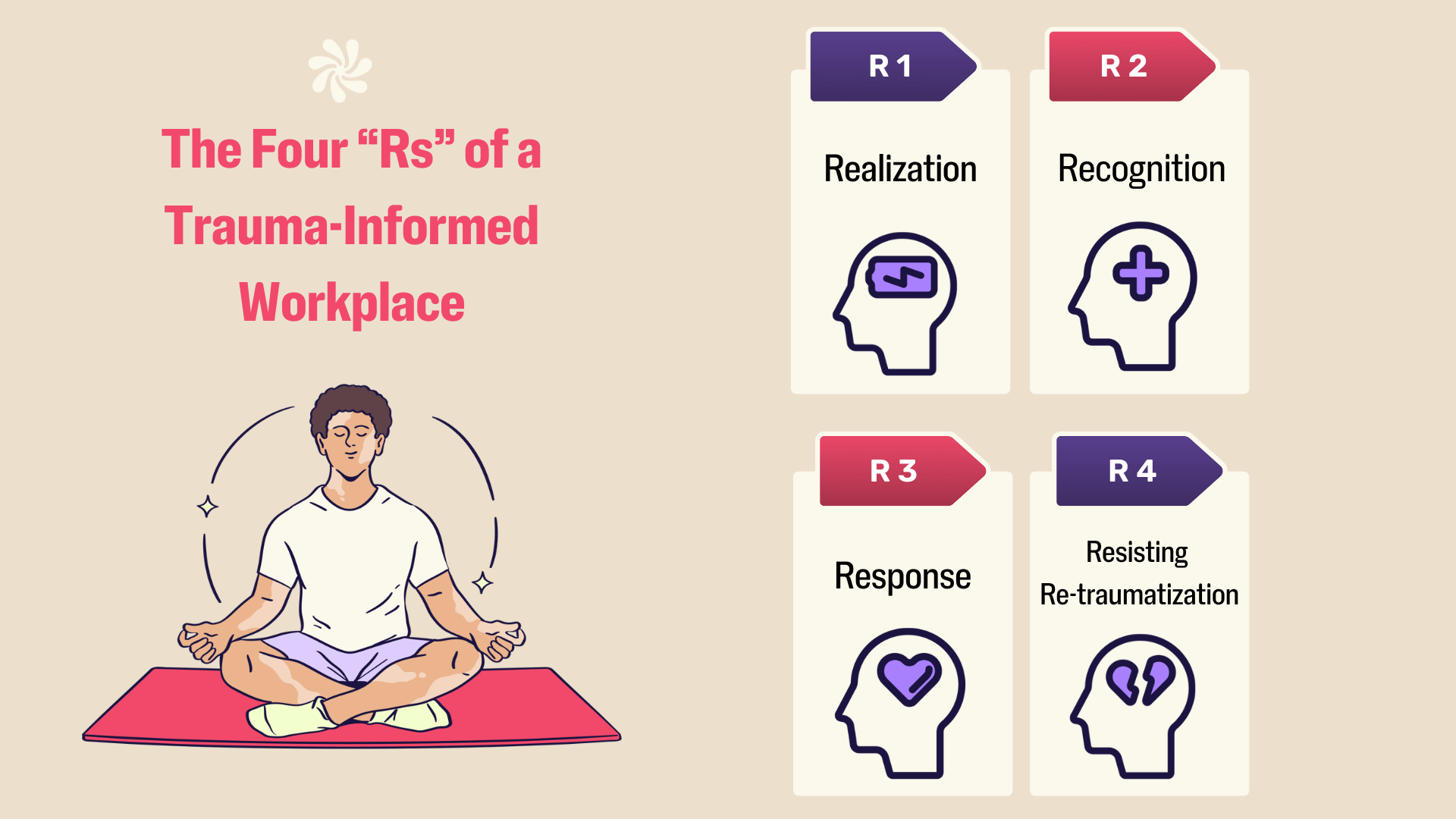What HR Leaders Need to Know about Trauma-Informed Workplaces
Last Updated Jan 28, 2025

How many people in your organization are carrying the weight of past traumas? It might be more than you expect!
Seven out of 10 of adults in the U.S. have had at least one traumatic experience at some point in their lives, according to the National Council for Behavioral Health. And what do such events lead to? Psychological stress, self-doubt, and the inability to solve problems — even in the workplace.
That's all bleak, but it's not a hopeless situation. As an HR leader, you can turn things around by championing a trauma-informed workplace. Turning your company into a safe space can help your employees heal from their traumatic experiences.
Ready to make that difference? Discover how a trauma-informed space can support your team’s holistic wellbeing.
What Is a Trauma-Informed Workplace?
A workplace that recognizes, understands, and responds to trauma and its negative effects on employees is trauma-informed.
Traumatic events can happen to anyone at any time. These can be public events, like environmental disasters to mass shootings, or personal tragedies, like a death in the family or an abusive relationship. Then there is secondhand trauma, or vicarious trauma, which can come from witnessing an event like a traffic accident or reading a news story about a bombing. Since everyone is at risk of experiencing trauma, every organization should be informed on how to respond during and after such occurrences.
Below are the characteristics of a trauma-informed workplace in line with the four assumptions ("R"s) of the Substance Abuse and Mental Health Services Administration’s (SAMHSA) — Realization, Recognition, Response, and Resisting Re-traumatization

Realization
Everyone in a trauma-informed organization — from the management to the employees, has a basic conceptualization of trauma and its effects. They understand trauma, how it affects people, and what steps one can take to heal and recover. An organization boosts trauma awareness by educating its staff on trauma-informed practices and hiring trauma-informed individuals.
Recognition
You can tell that a workplace is trauma-informed if it recognizes the signs and symptoms of trauma in its workforce and clients.
Since the effects of trauma manifest differently, an organization can detect these signs through screening and assessment. Managers at all levels, including HR leaders, are trained to notice various ways in which traumatic stress reactions may show up.
Response
In a trauma-informed workplace, everyone responds to trauma by blending knowledge with policies and strategies that promote recognition, healing, and recovery from traumatic experiences. It starts with the executives and trickles down to HR leaders and then to employees and clients.
Resisting Re-traumatization
Organizations that foster safe environments protect employees from practices that could trigger painful memories of their past trauma. They intentionally promote employees’ mental wellness and encourage collaboration and lifelong connections.
Benefits of a Trauma-Informed Workplace
An organization that teaches its employees how to deal with stressful events they may have encountered in their lives has a lot to gain.
Improved Mental Wellness
When an organization creates and implements a trauma-informed approach, it becomes a sanctuary that supports holistic wellbeing.
Investing in thriving employee wellbeing programs helps employees cope with stress and adversity and improves their mental wellness. It also reduces secondary trauma injuries (re-traumatization), which occur when an organization fails to support victims of trauma.
Improved Workplace Culture
Everyone would love to work in an organization where cohesion, empathy, inclusion, shared humanity, and acceptance are the norm. In a trauma-informed organization, executives lead with compassion and humility, and employees interact with empathy.
Improved Performance and Productivity
Employees in a trauma-informed workplace feel empowered, included, and understood. And this has a ripple effect on their performance and productivity. Employees who experience more flexibility, choice, and autonomy are more engaged in work. They are more than willing to step up and contribute to achieving organizational goals.
Decreased Absenteeism
In a supportive workplace, employees are less likely to be out of work repeatedly. Factors that cause absenteeism — including depression, burnout, and disengagement — are reduced in a trauma-informed workplace. And that’s because employees are happier, satisfied with their work, and have meaningful connections with their colleagues to look forward to.
Employee Retention
Employees will be willing to remain in an organization that is intentional about their wellness. On the other hand, according to Wellhub'sState of Work-Life 2024 report, 87% of employees would leave their jobs if the company didn’t focus on employee wellbeing.
Since employees are the backbone of every workplace, employers can increase engagement,reduce turnover rate, and retain the best talent when they show unwavering support to employees, especially during and after traumatic events.
Key Principles of a Trauma-Informed Workplace
Trauma-informed work environments follow six guiding principles provided for by the SAMHSA and Centers for Disease Control and Prevention (CDC).
Safety
Every person in an organization — from management to the staff and clients— should feel safe. Safety in a trauma-informed workplace goes beyond the physical setting to include psychological safety, as employees are happier when they feel safe and have healthy relationships at work.
Transparency and Trustworthiness
When an organization adopts a culture of transparency, it builds and maintains employee trust. Imagine a company where leaders regularly send out newsletters detailing the steps the company is taking to improve workplace safety and mental wellness. They provide clear information about employee assistance programs, share progress on mental health initiatives, and actively solicit feedback from employees. This open communication ensures that employees feel valued and confident that their wellbeing is a priority for the organization.
Peer Support
A trauma-informed workplace offers an environment where employees feel their colleagues have their backs. The organization provides all the necessary tools and resources to encourage peer support. This eases the journey to healing and recovery for trauma survivors and boosts their health.
Collaboration and Mutuality
In a supportive work environment, no individual exists in isolation. Everyone has a sense of belonging and feels that they have a role to play in driving organizational growth. Collaboration and mutuality come into play when managers encourage employees to work in harmony, as it boosts engagement.
Empowerment, Voice, and Choice
In a trauma-informed workplace, employers empower their employees by actively involving them in decision-making processes and valuing their unique skills and abilities. Rather than silencing or marginalizing their voices, leaders encourage open dialogue and respect employees’ autonomy in choosing whether to disclose their traumatic experiences.
On top of that, employees are invited to express their preferences and suggest the types of support their need, leading to an overall supportive and inclusive environment.
Cultural, Historical, and Gender Issues
An organization that adopts the trauma-informed approach moves beyond cultural, historical, and gender stereotypes. It swiftly takes action and addresses any gaps in the organizational culture that may encourage biases or discrimination. It then creates and implements an inclusive culture where everyone experiences respect and fair treatment.
Practical Tips for Becoming a Trauma-Informed Workplace
How can your organization become a trauma-informed workplace?
Adopt a Culture of Collaboration, Inclusion, Diversity, and Accessibility
To create a safe work environment, encourage trauma-informed language and values in all communications. You can implement regular training sessions on diversity and inclusion. Also, consider establishing employee resource groups (ERGs) that promote collaboration and support across different demographics. For instance, you can create a Diversity and Inclusion Council that meets regularly to discuss and address issues related to workplace diversity and to plan inclusive events and initiatives.
Adopt Supportive Leadership
Train managers at all levels to lead with empathy and humanity to boost employees’ trust in management. You can also encourage them to practice active listening skills, regularly check on their team members, and offer support. For example, you can start a ‘Manager as a Coach’ program where leaders receive ongoing training in empathetic leadership.
Develop and Implement Trauma-informed Supervision
Provide training for supervisors on trauma-informed approaches. You can also create guidelines for supervisors to ensure they listen to and validate employees’ traumatic experiences. That way, employees will feel safe, heard, and understood. For instance, you can have private, one-on-one meetings where supervisors and employees discuss work stress and wellbeing.
Provide More Choice, Flexibility, and Autonomy
Provide options for flexible hours, remote work, and personal days. Consider letting employees have a say in their workload and projects so that they feel empowered. You could, for example, introduce a ‘Flexible Fridays’ policy where employees choose their work location and hours that best fit their needs.
A Trauma-Informed Workplace Improves Mental Wellness and Resilience
Trauma can be the root cause of numerous workplace problems – absenteeism, unproductivity, conflicts, burnout, disengagement, and high turnover rates, to name a few. By adopting a trauma-informed approach, organizations can prevent and mitigate these challenges.
Your workplace can improve employees' mental wellness and resilience by encouraging values like collaboration, support, acceptance, inclusion, and empathy. At Wellhub, we are committed to helping forward-thinking HR leaders leverage the benefits of employee wellness. By investing in our data-backed wellbeing program, you can improve metrics such as employee performance, productivity, and retention.
Talk to a wellbeing specialist today to learn how you can help employees at your organization thrive!

Company healthcare costs drop by up to 35% with Wellhub*
See how we can help you reduce your healthcare spending.
[*] Based on proprietary research comparing healthcare costs of active Wellhub users to non-users.
You May Also Like
- Workplace Wellness: How to Harness This Productivity Superpower
- Supportive Leadership: How to Empower Your Team
- Variety is the Spice of (Work) Life: How Diversity and Inclusion Enhance Your Team
References
- National Library of Medicine. (n.d). Building a Trauma-Informed Workforce. Retrieved June 12, 2024, from https://www.ncbi.nlm.nih.gov/books/NBK207194/
- Centers for Disease Control and Prevention. (May 25, 2022). Building Trauma-Informed Communities. Retrieved June 12, 2024, from https://blogs.cdc.gov/publichealthmatters/2022/05/trauma-informed/
- Dennison, Kara. (October 24, 2023). Why Companies Should Prioritize Employee Health and Happiness in 2024. Forbes. Retrieved June 12, 2024, from https://www.forbes.com/sites/karadennison/2023/10/24/why-companies-should-prioritize-employee-health-and-happiness-in-2024/
- Greer, Jesse. (November 2, 2023). Introducing Trauma-Informed Care Principles in the Workplace. Springer. Retrieved June 12, 2024, from https://link.springer.com/article/10.1007/s44202-023-00094-2
- National Council for Behavioral Health. (n.d). How to Manage Trauma. Retrieved June 12, 2024, from https://www.thenationalcouncil.org/wp-content/uploads/2022/08/Trauma-infographic.pdf
- Ojo, A.O. (February 11, 2024). Influence of Workplace Flexibility on Employee Engagement Among Young People. ResearchGate. Retrieved June 12, 2024, from https://www.researchgate.net/publication/377982075_Influence_of_workplace_flexibility_on_employee_engagement_among_young_generation
- Peer Support Adaptation Project Advisory Group, Zheng, K., Spence, D. R., & Cusick, J. (June 1, 2022). SAMHSA’s Six Principles of Trauma-informed Care. Postsecondary Peer Support Training Curriculum. Retrieved June 12, 2024, from https://opentextbc.ca/peersupport/chapter/samhsas-six-principles-of-trauma-informed-care/
- SAMHSA’s Concept of Trauma and Guidance for a Trauma-Informed Approach. (n.d). National Coalition of Homeless Veterans. Retrieved June 12, 2024, from https://www.nchv.org/images/uploads/ResearchBrief_61-_SAMHSA_Trauma_Care.pdf
- Solon, Raquelle. (January, 2020). FEI Behavioral Health. How Trauma-Informed Communication Improves Workplace Culture. Retrieved June 12, 2024, from https://www.feinet.com/assets/uploads/2020/01/WPQ120_Trauma-Informed-Communication.pdf
- Trauma and Violence. (n.d). Substance Abuse and Mental Health Services Administration. Retrieved June 12, 2024, from https://www.samhsa.gov/trauma-violence
- Turmaud, D. R. (January 14, 2020). Watching the news can be traumatizing. Psychology Today. Retrieved June 12, 2024, from https://www.psychologytoday.com/us/blog/lifting-the-veil-trauma/202001/watching-the-news-can-be-traumatizing
Category
Share

The Wellhub Editorial Team empowers HR leaders to support worker wellbeing. Our original research, trend analyses, and helpful how-tos provide the tools they need to improve workforce wellness in today's fast-shifting professional landscape.
Subscribe
Our weekly newsletter is your source of education and inspiration to help you create a corporate wellness program that actually matters.
Subscribe
Our weekly newsletter is your source of education and inspiration to help you create a corporate wellness program that actually matters.
You May Also Like

5 Employee Fitness Challenges Drive Business Results | Wellhub
Use employee fitness challenges to cut healthcare costs, improve retention, and strengthen workplace culture without overwhelming your HR team.

How to Organize a Step Challenge at Work | Wellhub
Implementing a step challenge at work is a great way to engage employees in healthy competition while encouraging physical wellbeing.

How To Host a Hydration Challenge at Work | Wellhub
Proper hydration can boost performance through improved cognitive function. Hosting a hydration challenge at work can help encourage water intake.